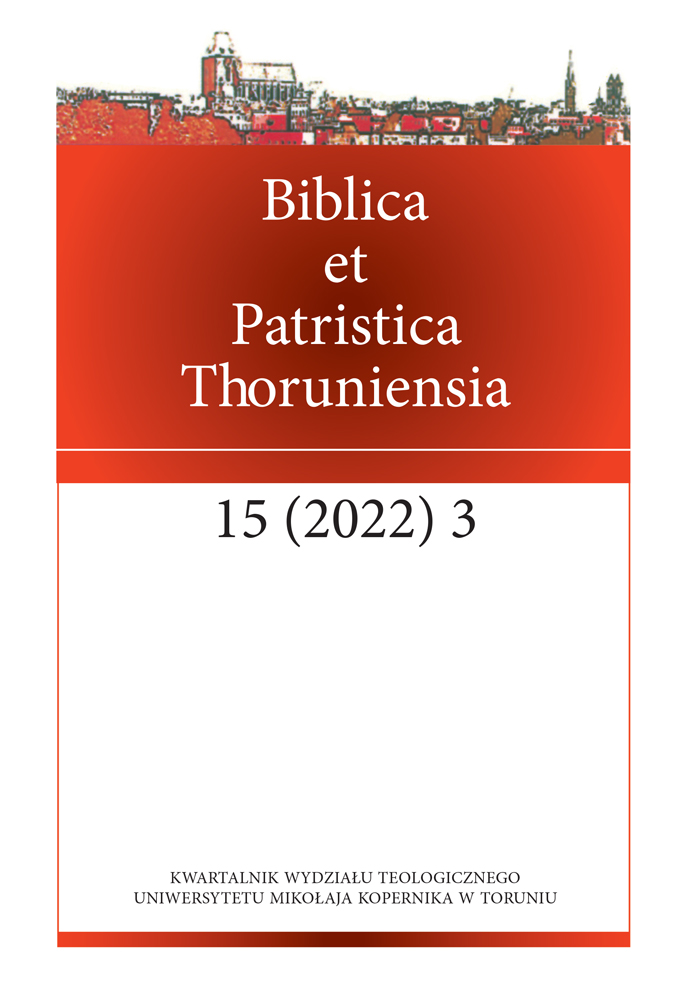The Structure of John 13:1–17 and its Application in the Christological-Soteriological, Baptismal and Ethical Interpretation
DOI:
https://doi.org/10.12775/BPTh.2022.014Keywords
Gospel of John, foot-washing, structure, narration, Chrystology, baptism, ethics, ecumenismAbstract
The article analyzes the structure of the description of the washing of the feet in John 13:1–17. John 13:1.3 and 13:17 create a frame (inclusio) where the material is divided into two parallel parts (4–10a and 12–16) and each part ends with a concluding gnome (10a and 16). Based on this structure the author suggests a christological-soteriological, baptismal and ethical interpretation. All three perspectives overlap but also each one is focused on different aspects of the text. The conclusion of the paper offers an ecumenical overview resulting from accepting these three perspectives.
References
Anderson, Paul N., Felix Just, and Tom Thatcher. 2009. John, Jesus and History II: Aspects of Historicity in the Fourth Gospel. Atlanta: Society of Biblical Literature.
Bauckham, Richard. 2007. The Testimony of the Beloved Disciple: Narrative, History and Theology in the Gospel of John. Grand Rapids: Baker.
Blaine, Bradford B. 2007. Peter in the Gospel of John: The Making of an Authentic Disciple. Leiden: Brill.
Brown, Raymond E. 1970. The Gospel According to John XIII–XXI (Anchor Bible 29A), Garden City: Doubleday.
Bultmann, Rudolf. 1963. Das Evangelium des Johannes. Berlin: Evangelisches Verlagsanstalt.
Chrzest znakiem jedności. Deklaracja Kościołów w Polsce na progu Trzeciego Tysiąclecia. 2000 https://ekumenia.pl/czytelnia/dokumenty-ekumeniczne/sakrament-chrztu-znakiem-jednosci/ [dostęp: 4.06.2022].
Harrison, James R. 2013. “The Imitation of Great Man in Antiquity: Paul’s Inversion of a Cultural Icon.” W Christian Origins and Greco-Roman Culture, edited by Stanley S. Rorter and Andrew W. Pitts, 213–254. Leiden: Brill.
Hochstedler, Andrew J. 2016. “Knowledge as an Interpretative Key for Foot Washing in John 13:2–20.” Miscellanea Francescana 116: 399–421.
Köstenberger Andreas J. 2004. John. (Baker Exegetical Commentary on the New Testament). Grand Rapids: Baker. [ePUB].
Kruse, Colin G., 2008. John: An Introduction and Commentary, Nottingham: Inter–Varsity Press [ePUB].
Luter, Marcin. 1992. Przedmowy do ksiąg biblijnych. Tłumaczenie Jerzy Krzyszpień. Warszawa: Towarzystwo Ogród Ksiąg.
Luterańska tożsamość i ekumenizm. 2020. Tłumaczenie Dariusz Bruncz. Warszawa: Wydawnictwo Warto.
Mędala, Stanisław. 2001. Chrystologia Ewangelii św. Jana. Kraków: Instytut Teologiczny Księży Misjonarzy.
Mędala, Stanisław. 2010, Ewangelia według św. Jana. Rozdziały 13–21. (Nowy Komentarz Biblijny Nowy Testament IV/2. Częstochowa: Edycja św. Pawła.
Moloney, Francis J. 1986. “The Structure and Massage of John 13:1–38”. Australian Biblical Review 34: 1–16.
Neyrey, Jerome H. and Eric Rowe. 2008. “Telling Time in the Fourth Gospel.” HTS Teologiese Studies/Theological Studies 64 no. 1: 291–320.
Paciorek, Antoni. 2000. Ewangelia umiłowanego ucznia. Lublin: Redakcja Wydawnictw Katolickiego Uniwersytetu Lubelskiego.
Parsenios, George L. 2014. First, Second and Third John. Grand Rapids: Baker.
Rahmsdorf, Olivia. 2019. „You shall not wash my feet (John 13:8): Time and Ethics in Peter’s Interactions with Jesus in the Johannine Narrative.” Journal for the Study of the New Testament 41 no. 4: 458– 477.
Siegert, Folker. 2008. Das Evangelium des Johannes in seiner ursprünglichen Gestalt: Wiederherstellung und Kommentar. Göttingen: Vandenhoeck & Ruprecht.
Thomas, John Christopher. 1991. Foot Washing in John 13 and the Johannine Community (Journal for the Study of the New Testament, Supplement Series 61) Sheffield: Sheffield Academic Press.
Watt van der, Jan. 2017. “The Meaning of Jesus Washing the Feet of His Disciples (John 13).” Neotestamentica 51 no. 1: 25–39.
Zachara, Maciej. 2013. Obmycie nóg jako ryt chrzcielny, cz 2. https://triduum.liturgia.pl/Obmycie-nog-jako-ryt-chrzcielny-cz-2/ [dostęp: 5.06.2022].
Downloads
Published
How to Cite
Issue
Section
License
Copyright (c) 2022 Kalina Wojciechowska

This work is licensed under a Creative Commons Attribution-NoDerivatives 4.0 International License.
CC BY ND 4.0. The Creator/Contributor is the Licensor, who grants the Licensee a non-exclusive license to use the Work on the fields indicated in the License Agreement.
- The Licensor grants the Licensee a non-exclusive license to use the Work/related rights item specified in § 1 within the following fields: a) recording of Work/related rights item; b) reproduction (multiplication) of Work/related rights item in print and digital technology (e-book, audiobook); c) placing the copies of the multiplied Work/related rights item on the market; d) entering the Work/related rights item to computer memory; e) distribution of the work in electronic version in the open access form on the basis of Creative Commons license (CC BY-ND 3.0) via the digital platform of the Nicolaus Copernicus University Press and file repository of the Nicolaus Copernicus University.
- Usage of the recorded Work by the Licensee within the above fields is not restricted by time, numbers or territory.
- The Licensor grants the license for the Work/related rights item to the Licensee free of charge and for an unspecified period of time.
FULL TEXT License Agreement
Stats
Number of views and downloads: 529
Number of citations: 0



